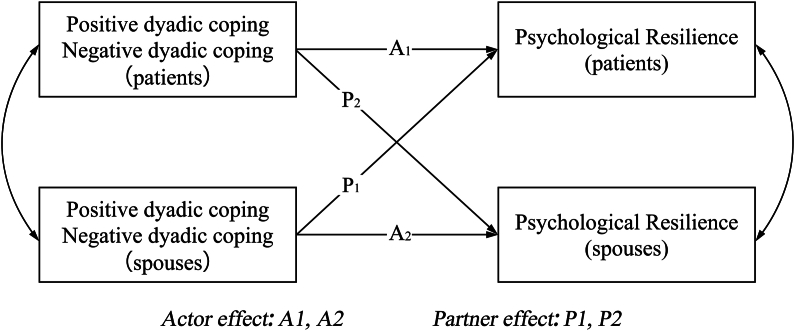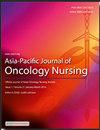西北地区宫颈癌夫妇二元应对与心理弹性的关系:一个行动者-伴侣相互依赖模型
IF 2.8
3区 医学
Q1 NURSING
引用次数: 0
摘要
目的:探讨二元应对(DC)对宫颈癌患者及其配偶心理弹性(PR)水平的影响。方法:于2024年4月至6月,对新疆省两所三级医院妇科和肿瘤科177对CC患者及其配偶进行横断面研究。通过人口统计资料、临床特征、心理弹性量表和二元应对量表等自我报告问卷收集数据。利用行动者-伙伴相互依存中介模型对结果进行了深入分析。结果:患者平均年龄49.94±8.05岁(范围:26 ~ 64岁),以CC II期患者居多,配偶平均年龄51.90±8.02岁(范围:27 ~ 65岁)。患者DC平均为105.50±23.98,配偶平均为103.34±22.26;PR平均为63.51±19.68,配偶平均为67.44±18.97。CC患者及其配偶中DC阳性与PR水平升高显著相关(r = 0.285, P r = 0.697, P r = -0.187, -0.390;结论:CC患者及其配偶的PR受双方DC行为的显著影响。当双方都使用积极的应对策略时,他们的PR会增加。相反,消极的DC行为只影响患者的PR,可能是由于自我隐瞒和沟通障碍,这可能是缺乏相互影响的原因。护士应识别出有负性抑郁风险的夫妇,并实施恢复力干预措施,鼓励双方积极应对。本文章由计算机程序翻译,如有差异,请以英文原文为准。



Interrelation between dyadic coping and psychological resilience among cervical cancer couples in Northwest China: An Actor-Partner interdependence model
Objective
This study aimed to explore how dyadic coping (DC) influences the psychological resilience (PR) levels of patients with cervical cancer (CC) and their spouses.
Methods
From April to June 2024, this cross-sectional study involved 177 dyads of patients with CC and their spouses from the gynecology and oncology wards of two tertiary hospitals in Xinjiang. Data were collected through questionnaires on demographic information, clinical characteristics, the Resilience Scale, and the Dyadic Coping Inventory, all of which were self-report measures. The results were thoroughly analyzed utilizing the Actor-Partner Interdependence Mediation Model.
Results
The patients had a mean age of 49.94 ± 8.05 years (range: 26–64), with the majority being at stage II of CC. Their spouses had a mean age of 51.90 ± 8.02 years (range: 27–65). DC scores averaged 105.50 ± 23.98 for patients and 103.34 ± 22.26 for spouses, while PR scores were 63.51 ± 19.68 for patients and 67.44 ± 18.97 for spouses. Positive DC, which significantly correlated with higher levels of PR, was observed in patients with CC and their spouses (r = 0.285, P < 0.01; r = 0.697, P < 0.01). Conversely, a negative DC was associated with a lower PR (r = −0.187, −0.390; P < 0.01). Positive DC by patients with CC and their spouses equally improves both partners' PR. In contrast, negative DC by patients with CC and their spouses affects only their own PR.
Conclusions
Patients with CC and their spouses' PR is significantly influenced by both partners' DC behaviors. When both partners used positive coping strategies, their PR increased. Conversely, negative DC behaviors affected only patients' PR, possibly because of self-concealment and communication barriers, which may explain the lack of a reciprocal impact. Nurses should identify couples at risk for negative DC and implement resilience interventions to encourage both partners' engagement in positive coping.
求助全文
通过发布文献求助,成功后即可免费获取论文全文。
去求助
来源期刊

Asia-Pacific Journal of Oncology Nursing
Multiple-
CiteScore
2.80
自引率
11.10%
发文量
136
审稿时长
31 days
 求助内容:
求助内容: 应助结果提醒方式:
应助结果提醒方式:


